North Carolina
state, United States
Introduction
North Carolina, flag of
 constituent state of the United States of America (United States). One of the 13 original states, it lies on the Atlantic coast midway between New York and Florida and is bounded to the north by Virginia, to the east by the Atlantic Ocean, to the south by South Carolina and Georgia, and to the west by Tennessee. The terrain of North Carolina is among the wettest in the country, with vast marshlands in the coastal tidewater area and numerous lakes in the Piedmont and Appalachian regions. These three physical regions account for much of the diversity in lifestyles and cultures within the state's boundaries. The capital is Raleigh.
constituent state of the United States of America (United States). One of the 13 original states, it lies on the Atlantic coast midway between New York and Florida and is bounded to the north by Virginia, to the east by the Atlantic Ocean, to the south by South Carolina and Georgia, and to the west by Tennessee. The terrain of North Carolina is among the wettest in the country, with vast marshlands in the coastal tidewater area and numerous lakes in the Piedmont and Appalachian regions. These three physical regions account for much of the diversity in lifestyles and cultures within the state's boundaries. The capital is Raleigh.

 constituent state of the United States of America (United States). One of the 13 original states, it lies on the Atlantic coast midway between New York and Florida and is bounded to the north by Virginia, to the east by the Atlantic Ocean, to the south by South Carolina and Georgia, and to the west by Tennessee. The terrain of North Carolina is among the wettest in the country, with vast marshlands in the coastal tidewater area and numerous lakes in the Piedmont and Appalachian regions. These three physical regions account for much of the diversity in lifestyles and cultures within the state's boundaries. The capital is Raleigh.
constituent state of the United States of America (United States). One of the 13 original states, it lies on the Atlantic coast midway between New York and Florida and is bounded to the north by Virginia, to the east by the Atlantic Ocean, to the south by South Carolina and Georgia, and to the west by Tennessee. The terrain of North Carolina is among the wettest in the country, with vast marshlands in the coastal tidewater area and numerous lakes in the Piedmont and Appalachian regions. These three physical regions account for much of the diversity in lifestyles and cultures within the state's boundaries. The capital is Raleigh. North Carolina's beginnings were tied closely to the earliest attempts at English colonization of North America. Roanoke Island in the northeast, a part of the heavily indented and island-fringed coast, was the site of the famous “ Lost Colony” that vanished sometime after the original landing in 1587. This eastern region retains some of the flavour of colonial life, while the Piedmont region, centred at Charlotte and Raleigh, has become the state's hub of industry and population. The mountains of the west remain the focus of a lively rural culture, including that of an indigenous Cherokee community that has lived in the region for centuries.
North Carolina's beginnings were tied closely to the earliest attempts at English colonization of North America. Roanoke Island in the northeast, a part of the heavily indented and island-fringed coast, was the site of the famous “ Lost Colony” that vanished sometime after the original landing in 1587. This eastern region retains some of the flavour of colonial life, while the Piedmont region, centred at Charlotte and Raleigh, has become the state's hub of industry and population. The mountains of the west remain the focus of a lively rural culture, including that of an indigenous Cherokee community that has lived in the region for centuries.Beginning in the mid-20th century, North Carolina experienced population growth at a much higher rate than the national average. This was largely attributable to its vibrant economy, which featured one of the strongest manufacturing sectors in the country—and the strongest in the South (South, the). At the same time, the state's service sector also expanded, keeping pace with the trend of the national economy. North Carolina's prosperity, natural beauty, and reputation for stable government have given it an image of progress and opportunity, even as it maintains its strong Southern identity. Area 52,671 square miles (136,417 square km). Pop. (2000) 8,049,313; (2007 est.) 9,061,032.
Land
Relief
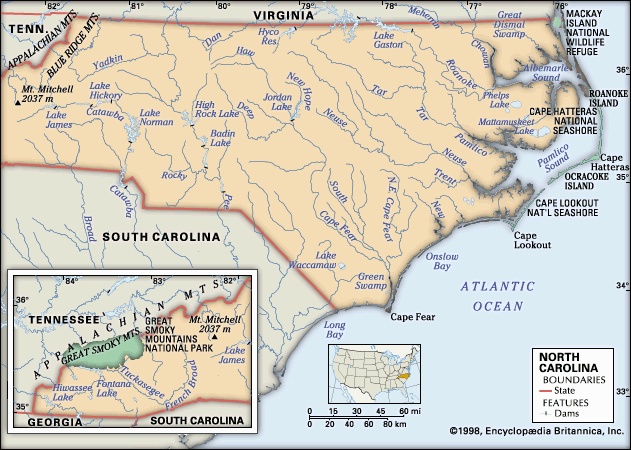
 North Carolina extends across three major physiographic regions of the United States—the Coastal Plain (or tidewater area), the Piedmont, and the Appalachian Mountains. In addition to producing a spectacular landscape, this regional variation has influenced the state's climate, soils, plant life, and human geography.
North Carolina extends across three major physiographic regions of the United States—the Coastal Plain (or tidewater area), the Piedmont, and the Appalachian Mountains. In addition to producing a spectacular landscape, this regional variation has influenced the state's climate, soils, plant life, and human geography.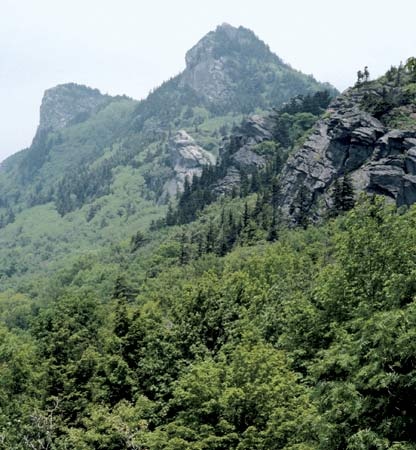 As the land reaches westward from sea level, it rises gradually to the fall line, a zone some 30 miles (50 km) in width that separates the Coastal Plain from the Piedmont. In the latter region, the topography becomes irregular, and the land rises about 5 feet (1.5 metres) per mile to the base of the Appalachians, a distance of about 140 miles (225 km). The mountains have a worn, rounded appearance, reflecting a geologic origin earlier than that of the rugged peaks of the American West. Mount Mitchell (Mitchell, Mount), rising to 6,684 feet (2,037 metres), is the highest peak east of the Mississippi (Mississippi River).
As the land reaches westward from sea level, it rises gradually to the fall line, a zone some 30 miles (50 km) in width that separates the Coastal Plain from the Piedmont. In the latter region, the topography becomes irregular, and the land rises about 5 feet (1.5 metres) per mile to the base of the Appalachians, a distance of about 140 miles (225 km). The mountains have a worn, rounded appearance, reflecting a geologic origin earlier than that of the rugged peaks of the American West. Mount Mitchell (Mitchell, Mount), rising to 6,684 feet (2,037 metres), is the highest peak east of the Mississippi (Mississippi River).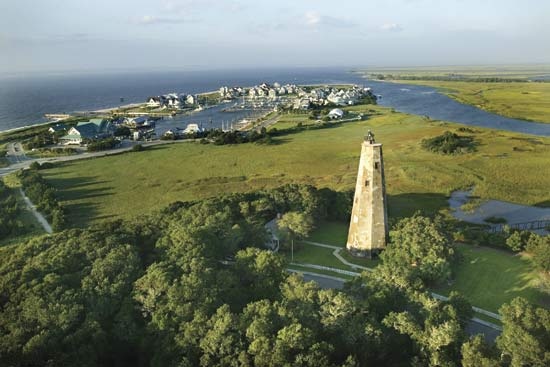 Composing nearly half the state, the Coastal Plain consists of a gently rolling, well-drained interior and a swampy tidewater area close to the coastline. The latter region was the first to be explored and settled. A long chain of islands, the Outer Banks, extends from Virginia to South Carolina, generally consisting of sand dunes that can reach 100 feet (30 metres) or more in height. Three capes—Hatteras (Cape Hatteras National Seashore), Lookout (Cape Lookout National Seashore), and Fear, the first two within national seashores—jut into the ocean in an area known as the “graveyard of the Atlantic,” a reference to the many ships that have sunk in its dangerous waters. The elevation of the entire area averages less than 20 feet (6 metres) above sea level. Only small-craft navigation is possible, because of silting and the shallow sounds and estuaries.
Composing nearly half the state, the Coastal Plain consists of a gently rolling, well-drained interior and a swampy tidewater area close to the coastline. The latter region was the first to be explored and settled. A long chain of islands, the Outer Banks, extends from Virginia to South Carolina, generally consisting of sand dunes that can reach 100 feet (30 metres) or more in height. Three capes—Hatteras (Cape Hatteras National Seashore), Lookout (Cape Lookout National Seashore), and Fear, the first two within national seashores—jut into the ocean in an area known as the “graveyard of the Atlantic,” a reference to the many ships that have sunk in its dangerous waters. The elevation of the entire area averages less than 20 feet (6 metres) above sea level. Only small-craft navigation is possible, because of silting and the shallow sounds and estuaries.The inner Coastal Plain extends 120 to 140 miles (190 to 225 km) westward to the Piedmont, which is a region of rolling, forested hills. The prominent ridges and hills of the eastern Piedmont may be the remains of an ancient mountain chain that paralleled the Appalachians, from which spurs extend into the western Piedmont. The area is well drained by rivers flowing into the Coastal Plain or South Carolina. Dams on the Catawba and Yadkin rivers are important sources of hydroelectric power.
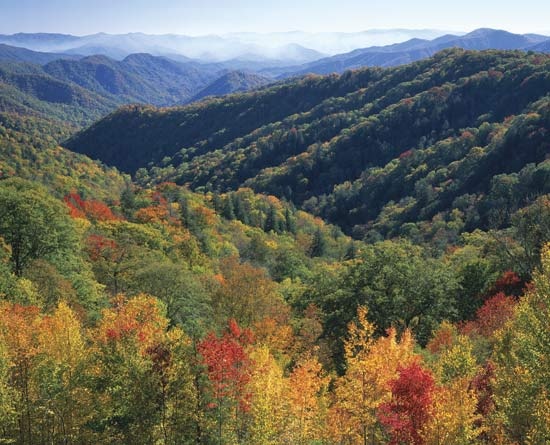 The mountain region comprises a plateau broken by two ranges of the southern Appalachians. On the east are the Blue Ridge Mountains (Blue Ridge), which rise steeply from the Piedmont to peaks of 3,000 to 4,000 feet (900 to 1,200 metres), with several reaching above 6,000 feet (1,800 metres). In the far west the Unaka Mountains contain the Great Smoky Mountains, which roll westward into Tennessee. This region is divided into several cross ridges and a number of smaller plateaus and basins. One of the chief ridges is made up of the Black Mountain (Black Mountains) group. Some 100 peaks rise above 5,000 feet (1,500 metres) in the western part of the state.
The mountain region comprises a plateau broken by two ranges of the southern Appalachians. On the east are the Blue Ridge Mountains (Blue Ridge), which rise steeply from the Piedmont to peaks of 3,000 to 4,000 feet (900 to 1,200 metres), with several reaching above 6,000 feet (1,800 metres). In the far west the Unaka Mountains contain the Great Smoky Mountains, which roll westward into Tennessee. This region is divided into several cross ridges and a number of smaller plateaus and basins. One of the chief ridges is made up of the Black Mountain (Black Mountains) group. Some 100 peaks rise above 5,000 feet (1,500 metres) in the western part of the state.Drainage and soils
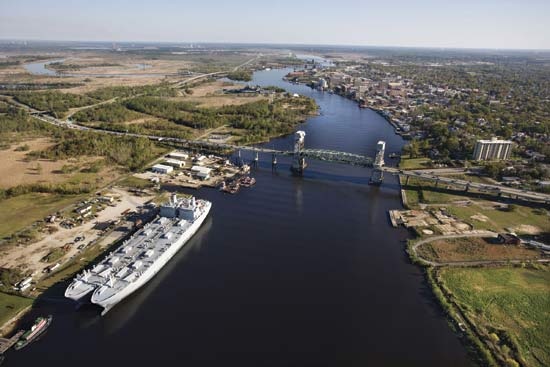 North Carolina has some 3,820 square miles (9,890 square km) of inland water, the third largest such area of any state. Lake Mattamuskeet, covering some 63 square miles (162 square km) in the state's eastern tidewater area, is North Carolina's largest natural lake. Lakes are especially abundant in the Catawaba River basin of the state's southwest Piedmont and Appalachian region; the river itself is largely a chain of man-made reservoirs. The Catawba is the most densely populated river basin in the state. The Cape Fear River basin, which occupies much of North Carolina's southeastern quadrant, is the largest. The Roanoke River drains the state's northeastern corner, flowing southeast from Virginia into the ocean at Albermarle Sound. Bisecting North Carolina from north to south is the Yadkin– Pee Dee River. The Little Tennessee (Little Tennessee River) and French Broad (French Broad River) rivers flow northwest from the mountains of North Carolina into Tennessee. Raleigh is drained by the Neuse River, which empties into the Atlantic at New Bern.
North Carolina has some 3,820 square miles (9,890 square km) of inland water, the third largest such area of any state. Lake Mattamuskeet, covering some 63 square miles (162 square km) in the state's eastern tidewater area, is North Carolina's largest natural lake. Lakes are especially abundant in the Catawaba River basin of the state's southwest Piedmont and Appalachian region; the river itself is largely a chain of man-made reservoirs. The Catawba is the most densely populated river basin in the state. The Cape Fear River basin, which occupies much of North Carolina's southeastern quadrant, is the largest. The Roanoke River drains the state's northeastern corner, flowing southeast from Virginia into the ocean at Albermarle Sound. Bisecting North Carolina from north to south is the Yadkin– Pee Dee River. The Little Tennessee (Little Tennessee River) and French Broad (French Broad River) rivers flow northwest from the mountains of North Carolina into Tennessee. Raleigh is drained by the Neuse River, which empties into the Atlantic at New Bern.Soils in North Carolina are commonly grouped according to regional variations. Coastal soils are rich and humus-laden, while farther to the west the hills consist mostly of sand and have almost no organic materials. The Piedmont region is predominately clayey, and mountain soils are a combination of clay, sand, and silt, commonly called loam. All of North Carolina's soils are affected by excessive leaching, which causes high mineral loss, and successful agriculture depends on large additions of lime and fertilizers.
Climate
North Carolina's climate ranges from medium continental conditions in the mountain region, though summers are cooler and rainfall heavier, to the subtropical conditions of the state's southeastern corner. The growing season ranges from 275 days along the coast to 175 days in the mountains. Average annual temperatures range from 66 °F (19 °C) in the eastern region to 60 °F (16 °C) in the central region and 55 °F (13 °C) in the mountains. July and August are the wettest months, and October and November are the driest. Annual precipitation varies from 46 to 54 inches (1,170 to 1,370 mm) on the coast, 44 to 50 inches (1,120 to 1,270 mm) in the Piedmont, and 40 to 80 inches (1,015 to 2,030 mm) in the mountains. Severe storms are rare and heavy snow infrequent. Hurricanes occasionally occur along the coast, and there have been tornadoes inland.
Plant and animal life
Vegetation varies greatly throughout the state, primarily because of the geographic and climatic differences between the three main regions. However, changes effected by human habitation are perhaps becoming an equally significant determinant of the state's biodiversity. Although more than half the state is still covered with forests, many trees have been cut and burned, not only affecting animal life by changing important habitats but also contributing to soil erosion and leaching.
 A broad spectrum of plant life is found in North Carolina, including many species of hardwood trees. Red spruces and balsam firs are found in the mountains, and the subtropical palmetto and the carnivorous pitcher plant (genus Sarracenia) and Venus's-flytrap (Dionaea muscipula) grow in the southern coastal area.
A broad spectrum of plant life is found in North Carolina, including many species of hardwood trees. Red spruces and balsam firs are found in the mountains, and the subtropical palmetto and the carnivorous pitcher plant (genus Sarracenia) and Venus's-flytrap (Dionaea muscipula) grow in the southern coastal area.The common fauna of North America, including rabbits, squirrels, raccoons, opossums, deer, and also bears and wildcats, are found within the state. Since the late 1980s, efforts have been under way to reintroduce the nearly extinct red wolf to North Carolina. The commonest birds are cardinals, wrens, mockingbirds, chickadees, and many varieties of woodpeckers and warblers. Freshwater fishes such as bluegills, crappie, bass, and sunfish are common in the inland areas. Brook and rainbow trout are found in the mountains.
People
Population composition
It is estimated that North Carolina was already inhabited by 35,000 to 50,000 indigenous people—primarily the Tuscarora and Catawba in the Coastal Plain and the Cherokee in the Appalachian Mountains—by the time the first European explorers arrived in the mid-16th century. In the late 1830s most of the largest remaining group of native people, the Cherokee, were forcibly removed to lands west of the Mississippi, an exodus recorded in history as the Trail of Tears (1838–39). Some Cherokee and other indigenous peoples remained in North Carolina, however, and by the early 21st century roughly 100,000 Native Americans lived in the state, constituting the largest indigenous population of any state east of the Mississippi River.
Permanent European settlers came into North Carolina in the 1650s from the English colony at Jamestown (Jamestown Colony), Va. Others came down on the great wagon road from Pennsylvania through the Shenandoah Valley and into the Piedmont. Some came by ship from Europe. All yearned for a plot of land and for freedom from rigid class and religious restrictions. The early North Carolinians were a heterogeneous group, representing a variety of religions, nationalities, and economic and social classes. The Anglican church was established by law in the early 18th century, but there were also Presbyterians, Quakers, Moravians, Lutherans, Reformed, Baptists, Methodists, and a small number of Jews. Nationalities represented included English, Scottish, Irish, Welsh, Swiss, French, and German. The white, Euro-American community expanded over the centuries, amounting to nearly three-fourths of North Carolina's population by the early 21st century.
Slaves of African descent were an important part of the early North Carolina population; the labour-intensive crops of rice, indigo, tobacco, and cotton stimulated the spread of slavery in the state, especially after the appearance of the cotton gin in the 1790s. In the early 21st century, African Americans accounted for about one-fifth of the population. Although disparities between the living conditions of white and black North Carolinians remain, a growing number of African Americans in the state have secured prominent positions in education, arts, sports, business, and politics.
North Carolina's Hispanic population, though still a small minority, has been growing rapidly; the Hispanic community more than doubled in size between 1990 and 2000. Many of the state's newer Hispanic residents came from Mexico largely in pursuit of employment in agriculture or manufacturing or on one of the state's military installations.
Settlement patterns
In the sparsely populated mountain regions, especially in North Carolina's southwest, ways of life have changed more gradually than in urban areas. Many communities, relatively isolated since the early history of the state, long remained self-sufficient. By the late 20th century, however, the isolation had been broken, with Asheville having become a resort centre and the surrounding slopes, national parks, and forests an all-season draw for tourists and outdoors enthusiasts.
 The Piedmont region is a prime symbol of the New South, in which the modern manufacturing industry has largely replaced the traditional agriculture. A concentration of industry occurs in a sweeping crescent westward and southward from Raleigh to below Charlotte, the state's largest city. This crescent experienced the greatest increase in population in the late 20th and early 21st centuries. Rapid growth of such cities as Durham, Greensboro, and Winston-Salem has made North Carolina a leader in the country's tobacco industry and significant in textiles and furniture production. The colleges and universities that have been most influential in the state's history have also attracted residents to the Piedmont region.
The Piedmont region is a prime symbol of the New South, in which the modern manufacturing industry has largely replaced the traditional agriculture. A concentration of industry occurs in a sweeping crescent westward and southward from Raleigh to below Charlotte, the state's largest city. This crescent experienced the greatest increase in population in the late 20th and early 21st centuries. Rapid growth of such cities as Durham, Greensboro, and Winston-Salem has made North Carolina a leader in the country's tobacco industry and significant in textiles and furniture production. The colleges and universities that have been most influential in the state's history have also attracted residents to the Piedmont region.Despite the large industrial employment, about one-third of North Carolina's population remains rural. Many industrial plants are located in small towns, but a good portion of their workforce commutes from rural regions. Rapid urbanization and the persistence of extremely rural areas accentuate the demographic contrasts in the state. Traditional patterns of subsistence and small-farm agriculture, however, are giving way to the consolidated farms of agribusiness.
Economy
North Carolina's economy was based mainly on the growing of tobacco in the 1700s and 1800s and on the manufacture of tobacco products and textiles in the early 1900s. While these activities remain important segments of the state's economy, they have largely been overshadowed by other industries and services. In the late 20th and early 21st centuries North Carolina's economy generated jobs at a higher rate than the national average in many areas.
Agriculture and forestry
Agriculture remains a small but important component of the state's economy, although the number of people it employs continues to decline. There are nearly 50,000 farms in the state; the great majority are relatively small—about 180 acres (75 hectares) or less—and most are operated by people who earn much of their income from farming. North Carolina is a national leader in the production of sweet potatoes, dry beans, tobacco, pigs, broilers (chickens), and turkeys. Other principal agricultural products include eggs, soybeans, and cotton. Farm income tends to be greatest in the central and southern counties of the Coastal Plain.
With its abundance of forests, North Carolina has long been a leader in the production of lumber, wood for furniture, Christmas trees, pulp for paper, and other wood products. The principal trees are pines, largely harvested in the Coastal Plain and the Piedmont region. Hardwoods such as oak, hickory, ash, and poplar are drawn primarily from the Appalachian Mountains and parts of the Piedmont. Several active reforestation and forest sustainability programs have resulted in a growth of forest reserves, for both commercial and private or otherwise nonindustrial use.
Resources and power
In addition to its forest resources, North Carolina has large reserves of nonmetallic rocks and minerals. The state is a leader in the production of phosphate rock, lithium minerals, feldspar, olivine, mica, and pyrophillite. Many of these resources are used in the construction industry, along with dimension and building stone, crushed granite, common clay (for bricks), gravel, and sand. Various gemstones are also found in the state.
North Carolina's electric power is generated mainly by coal-fired thermal plants, with several nuclear stations supplying nearly one-third of the total. Most of the remainder is produced by the state's numerous hydroelectric dams.
Manufacturing
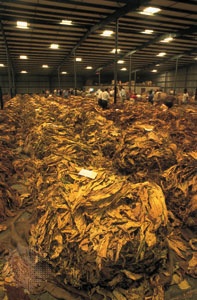 For nearly a century North Carolina has remained the most successful manufacturing state in the South and one of the top manufacturing states in the country. Aside from developing solid tobacco and textile industries in the 20th century, the state also emerged as a major centre for furniture making. Throughout the first half of the century, nearly half of the state's nonfarm workforce was employed in those three industries, but since the 1970s the state has steadily lost textile jobs. By the early 21st century, manufacturing accounted for less than one-fifth of all employment and for roughly one-fifth of the gross domestic product (GDP). The industrial base had become more diversified, with especially strong growth in computers, electronic communications equipment, chemicals, and machinery. Production of processed foods, particularly for domestic consumption, also has commanded a significant share of the sector.
For nearly a century North Carolina has remained the most successful manufacturing state in the South and one of the top manufacturing states in the country. Aside from developing solid tobacco and textile industries in the 20th century, the state also emerged as a major centre for furniture making. Throughout the first half of the century, nearly half of the state's nonfarm workforce was employed in those three industries, but since the 1970s the state has steadily lost textile jobs. By the early 21st century, manufacturing accounted for less than one-fifth of all employment and for roughly one-fifth of the gross domestic product (GDP). The industrial base had become more diversified, with especially strong growth in computers, electronic communications equipment, chemicals, and machinery. Production of processed foods, particularly for domestic consumption, also has commanded a significant share of the sector.Services
Since 1950, North Carolina's service activities have expanded rapidly. Major military installations, as well as a diverse tourism sector, have become important contributors to the state's economy. In the 1980s and '90s Charlotte became both a regional and national centre for banking operations. In addition, the Raleigh–Durham–Chapel Hill area (dubbed the Research Triangle) has grown to encompass a wide variety of research and development activities and has spurred much new job growth, mainly in technology-based manufacturing and services. The service sector, including hospitality (restaurants and accommodations) as well as professional, scientific, technical, health care, and social services, constitutes a major portion of the state's GDP.
Transportation
Geographically, North Carolina is one day's trucking time both north to New York City and south to the rapidly expanding Florida market. The vast majority of freight is transported by road using the state's highway system; most of the remainder is carried by rail. The state has several commercial airports, although only two—at Raleigh-Durham and Charlotte—offer international passenger service. Those two facilities serve as hubs for national airlines, providing direct flights to many domestic destinations. A number of regional airports offer short flights to larger connecting cities. Deepwater ports at Wilmington and Morehead City are North Carolina's two Atlantic gateways to world markets and are equipped to handle any type of cargo. The Intracoastal Waterway threads its way between the Outer Banks and the mainland from New Jersey to the Gulf of Mexico.
Government and society
Constitutional framework
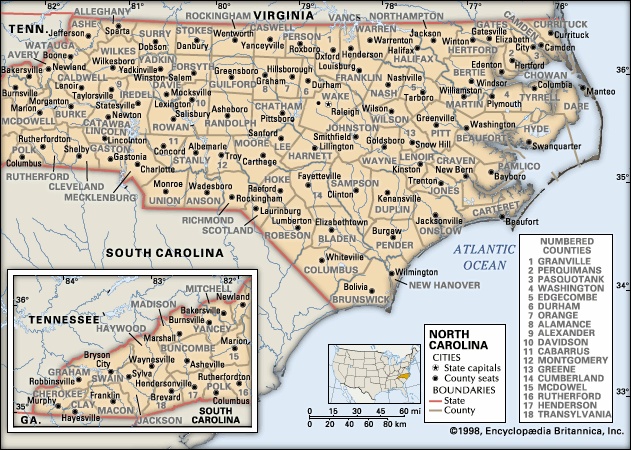 The structure of the government of North Carolina is based on constitutions of 1776, 1868, and 1971. Administration of the state is supervised by elected executives, including the governor and lieutenant governor (each limited to two four-year terms, not necessarily consecutive), and by the heads of state agencies, some of whom are elected for four-year terms and some of whom are appointed. The General Assembly consists of the 50-member Senate and the 120-member House of Representatives. Both senators and representatives are elected for two-year terms. The governor has great appointive powers and, since 1996, the authority to veto legislation. Gubernatorial vetoes may be overridden, however, by a vote of three-fifths of those present in each house of the General Assembly.
The structure of the government of North Carolina is based on constitutions of 1776, 1868, and 1971. Administration of the state is supervised by elected executives, including the governor and lieutenant governor (each limited to two four-year terms, not necessarily consecutive), and by the heads of state agencies, some of whom are elected for four-year terms and some of whom are appointed. The General Assembly consists of the 50-member Senate and the 120-member House of Representatives. Both senators and representatives are elected for two-year terms. The governor has great appointive powers and, since 1996, the authority to veto legislation. Gubernatorial vetoes may be overridden, however, by a vote of three-fifths of those present in each house of the General Assembly. The state is divided into more than 40 judicial districts. District courts deal primarily with less-serious civil and criminal matters. Each district elects, for four-year terms, its district court judges and a district attorney, who represents the state in all criminal matters. The superior courts handle the more-serious criminal and civil cases. Superior court judges for each district are chosen in statewide elections for terms of eight years. Above the superior courts are the Court of Appeals and the Supreme Court. The latter is the highest state court; it has seven justices elected for eight-year terms (justices may run for reelection). The Court of Appeals was established by a constitutional amendment in 1967 to help relieve the state's Supreme Court. It has 15 judges, all elected for eight-year terms.
The state is divided into more than 40 judicial districts. District courts deal primarily with less-serious civil and criminal matters. Each district elects, for four-year terms, its district court judges and a district attorney, who represents the state in all criminal matters. The superior courts handle the more-serious criminal and civil cases. Superior court judges for each district are chosen in statewide elections for terms of eight years. Above the superior courts are the Court of Appeals and the Supreme Court. The latter is the highest state court; it has seven justices elected for eight-year terms (justices may run for reelection). The Court of Appeals was established by a constitutional amendment in 1967 to help relieve the state's Supreme Court. It has 15 judges, all elected for eight-year terms.North Carolina is divided into 100 counties. County governments act for the state in providing education, health care, and welfare services. Locally elected officials for each county include county commissioners, a sheriff, a registrar of deeds, a clerk of the superior court, and members of the school board.
Compared with those of many other states, North Carolina's local government is fairly uncomplicated. In general, counties provide services that apply to all citizens of the state, while municipalities provide the additional services appropriate for urban areas. As urban development has continued, counties have been authorized to offer services that are similar to those provided by municipalities, such as water supply and garbage collection. Because North Carolina's constitution discourages the incorporation of municipalities near existing ones, North Carolina is relatively free from the proliferation of new municipal governments in urban areas that is found in many other states.
North Carolina has long been dominated by the Democratic Party. The majority of state and local officeholders are Democrats, but candidates from the rival Republican Party have made major gains. Since 1970 the number of Republicans in the General Assembly has increased, and the state has usually voted Republican in presidential elections. North Carolina has also elected Republicans to the U.S. Senate and House of Representatives and, on occasion, to the governorship.
Health and welfare
State-funded hospitals cover a number of specialized areas, such as children's development, alcoholism, retardation and mental illness, and tuberculosis. An effective public health program has been in operation since 1877, and each county has a local health department. State aid is provided to senior citizens and people with disabilities, to families with dependent children, and to various counseling and other social service programs. However, the state's per capita social expenditures remain far below the national average.
Education
The public school system, supported by the state since 1933, has improved steadily, though it is still below national levels. Although expenditures for education remain in the bottom quintile nationwide, North Carolina has made significant increases since the late1990s.
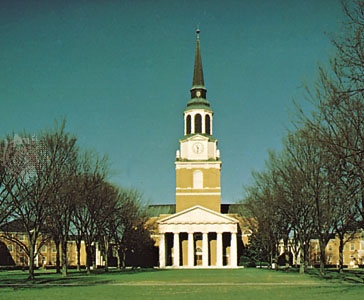 In higher education, however, North Carolina has a number of institutions of national standing. The University of North Carolina (North Carolina, University of) (UNC) opened its doors to students at Chapel Hill in 1795 as the first state university in the United States. Since 1972 all 16 senior public institutions have been part of the UNC system, and all are governed by a single board elected by the General Assembly. In addition to Chapel Hill, its campuses include North Carolina State University (1887) at Raleigh; the North Carolina School of the Arts (1963) at Winston-Salem, which was the first state-supported residential school for the performing arts; and North Carolina Agricultural and Technical State University (1891) at Greensboro, one of the largest historically black institutions in the country. The state's community college system, which comprises more than 50 institutions, is one of the largest in the United States. Most of North Carolina's many private colleges and universities were established by various Protestant denominations. Of these institutions, Duke University (1839) in Durham, Wake Forest University (1834) in Winston-Salem, and Davidson College (1837) in Davidson are among the most prominent.
In higher education, however, North Carolina has a number of institutions of national standing. The University of North Carolina (North Carolina, University of) (UNC) opened its doors to students at Chapel Hill in 1795 as the first state university in the United States. Since 1972 all 16 senior public institutions have been part of the UNC system, and all are governed by a single board elected by the General Assembly. In addition to Chapel Hill, its campuses include North Carolina State University (1887) at Raleigh; the North Carolina School of the Arts (1963) at Winston-Salem, which was the first state-supported residential school for the performing arts; and North Carolina Agricultural and Technical State University (1891) at Greensboro, one of the largest historically black institutions in the country. The state's community college system, which comprises more than 50 institutions, is one of the largest in the United States. Most of North Carolina's many private colleges and universities were established by various Protestant denominations. Of these institutions, Duke University (1839) in Durham, Wake Forest University (1834) in Winston-Salem, and Davidson College (1837) in Davidson are among the most prominent.Cultural life
Eastern North Carolina has been the citadel of the state's colonial history and European cultural heritage ever since Sir Walter Raleigh (Raleigh, Sir Walter)'s dream of colonization at Roanoke came to so mysterious an end. Legends tell of pirate treasure buried beneath the dunes of the Outer Banks, and rusting smokestacks, masts, and boilers protrude from offshore waters, testimony to the more than 2,000 ships that have gone down. Nearby Nags Head got its name, according to tradition, because unscrupulous robber-settlers tied lanterns to their horses' necks and drove them along the coast to lure unsuspecting seamen to run aground on the reefs. On Ocracoke Island, visitors are astonished at the Elizabethan-sounding speech of the residents, for whom “high tide” is “hoigh toide.”
In New Bern—the state's second oldest town, named by its Swiss settlers—is Tryon Palace, a restored mansion and garden that is considered one of the most beautiful buildings in the colonial Americas. Along the southern coast, fishermen set out to battle large deepwater fish of the Gulf Stream, and in Edenton memories survive of the colonial ladies who held one of the first “tea parties” to boycott tea and other products from England as a protest against duties imposed by the British.
In recognition of North Carolina's unique history and cultural heritage, an arts council was established in 1964. Now part of the state's Department of Cultural Resources, the council assists in bringing the highest obtainable quality in the arts to the greatest number of people in the state and also in expanding the role of the arts. The council makes grants of public funds to sponsor numerous projects. North Carolina was the first state in the country to set aside public funds for the purchase of an art collection. Housed at the North Carolina Museum of Art (1947) in Raleigh, the collection spans some 5,000 years, from the art of ancient Egypt to contemporary works. The North Carolina Museum of Natural Sciences (1879; reopened 2000), also in Raleigh, was the state's first public museum.
The North Carolina Symphony has the distinction of being the first state-supported orchestra in the country. The ensemble tours the state from September through May. Many of the performances are free matinees for children.
The Piedmont and Appalachian regions are renowned for their old-time guitar, fiddle, and string-band traditions, as well as their bluegrass players. Among the best-known of these musicians is guitarist Doc Watson, who was a major force behind the American folk music revival of the 1960s; MerleFest, named for Watson's late son Merle and held each spring in the Piedmont town of Wilkesborough, draws large crowds to hear some of the country's finest players of bluegrass and other regional styles. Other celebrations of American “roots” music, including numerous bluegrass and fiddle festivals, are also held throughout the Appalachian region.
North Carolina excels in the fields of rural arts and historical pageantry. Wood carving, basketry, needlework, rug and quilt making, ceramics, and other cottage industries of the western mountains combine with arts of the coastal communities to offer some of the richest regional culture in the United States. Outdoor epic dramas are held throughout the summer in Manteo on Roanoke Island, where Paul Green (Green, Paul)'s play The Lost Colony revives the colonizing efforts of Sir Walter Raleigh in the court of Elizabeth I and on the soil of Roanoke itself; in Boone, where The Horn in the West re-creates such characters as Daniel Boone (Boone, Daniel); and in Cherokee, where Unto These Hills is played by the descendants of the Cherokee Indians upon whose history the saga is based.
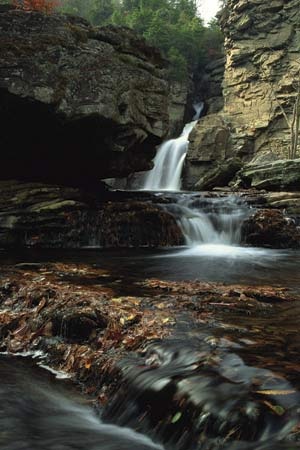 The lakes and the upper reaches of North Carolina's rivers provide havens for fishing and camping. The state shares with Tennessee the Great Smoky Mountains National Park, which occupies some 815 square miles (2,110 square km) of mountain forestland; one of the most heavily visited parks in the country, it was designated a UNESCO World Heritage site in 1983. The Appalachian National Scenic Trail passes through the park, and the southern terminus of the Blue Ridge Parkway begins in the park and extends to Shenandoah National Park in Virginia. Pisgah National Forest is also a popular destination for a growing number of tourists and outdoors enthusiasts, as are Cape Hatteras and Cape Lookout national seashores, which encompass a large portion of the Outer Banks. Other National Park Service sites mark the first English settlement on Roanoke Island (Fort Raleigh National Historic Site), the Wright brothers (Wright, Wilbur and Orville)' first flight at Kill Devil Hills (Wright Brothers' National Memorial), the home of writer Carl Sandburg (Sandburg, Carl) in Henderson county (Carl Sandburg Home National Historic Site), and the battles at Guilford Courthouse (Guilford Courthouse, Battle of) and Moore's Creek Bridge. The Biltmore estate and mansion near Asheville, built by George Washington Vanderbilt (Vanderbilt Family), is also a popular tourist destination.
The lakes and the upper reaches of North Carolina's rivers provide havens for fishing and camping. The state shares with Tennessee the Great Smoky Mountains National Park, which occupies some 815 square miles (2,110 square km) of mountain forestland; one of the most heavily visited parks in the country, it was designated a UNESCO World Heritage site in 1983. The Appalachian National Scenic Trail passes through the park, and the southern terminus of the Blue Ridge Parkway begins in the park and extends to Shenandoah National Park in Virginia. Pisgah National Forest is also a popular destination for a growing number of tourists and outdoors enthusiasts, as are Cape Hatteras and Cape Lookout national seashores, which encompass a large portion of the Outer Banks. Other National Park Service sites mark the first English settlement on Roanoke Island (Fort Raleigh National Historic Site), the Wright brothers (Wright, Wilbur and Orville)' first flight at Kill Devil Hills (Wright Brothers' National Memorial), the home of writer Carl Sandburg (Sandburg, Carl) in Henderson county (Carl Sandburg Home National Historic Site), and the battles at Guilford Courthouse (Guilford Courthouse, Battle of) and Moore's Creek Bridge. The Biltmore estate and mansion near Asheville, built by George Washington Vanderbilt (Vanderbilt Family), is also a popular tourist destination. North Carolina's major professional sports teams include the Panthers (gridiron football) and Bobcats (basketball) in Charlotte and the Hurricanes (ice hockey) in Raleigh. The state is renowned for its many golf courses, notably those at Pinehurst and Greensboro that have hosted major national and international professional championships. North Carolina colleges and universities have had great success in intercollegiate sports over the years, especially in basketball, with Duke and UNC being two of the country's perennial powerhouses.
North Carolina's major professional sports teams include the Panthers (gridiron football) and Bobcats (basketball) in Charlotte and the Hurricanes (ice hockey) in Raleigh. The state is renowned for its many golf courses, notably those at Pinehurst and Greensboro that have hosted major national and international professional championships. North Carolina colleges and universities have had great success in intercollegiate sports over the years, especially in basketball, with Duke and UNC being two of the country's perennial powerhouses.North Carolina is served by dozens of daily newspapers, of which the most noteworthy are The Charlotte Observer and Raleigh's The News & Observer. The state has about 150 radio stations and more than 30 television stations.
History
Before European contact
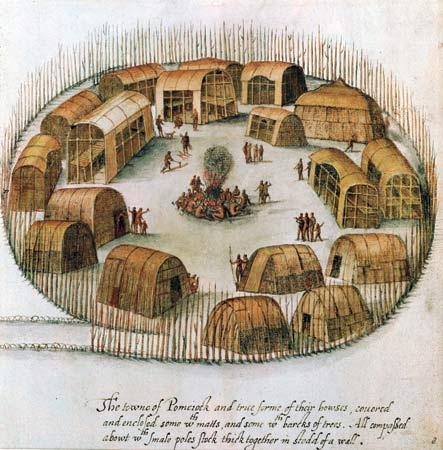 The earliest indigenous inhabitants of North Carolina had arrived by at least 8000 BC; they may have been there much earlier. These were people of the Paleo-Indian culture, and, like their successors, the Archaic (Archaic culture) people, they lived mainly by hunting. The Woodland culture (Woodland cultures) flourished in the area from about 1000 BC as the people began to make pottery, to farm, and to build ceremonial mounds. The Mississippian culture, which followed about AD 800, had a more hierarchical social order and stronger political organization but was otherwise similar to the Woodland culture in its advanced agricultural system and tradition of mound building. At the time of European contact, there were various indigenous groups in the area; the dominant ones were the Tuscarora, the Catawba, and the Cherokee.
The earliest indigenous inhabitants of North Carolina had arrived by at least 8000 BC; they may have been there much earlier. These were people of the Paleo-Indian culture, and, like their successors, the Archaic (Archaic culture) people, they lived mainly by hunting. The Woodland culture (Woodland cultures) flourished in the area from about 1000 BC as the people began to make pottery, to farm, and to build ceremonial mounds. The Mississippian culture, which followed about AD 800, had a more hierarchical social order and stronger political organization but was otherwise similar to the Woodland culture in its advanced agricultural system and tradition of mound building. At the time of European contact, there were various indigenous groups in the area; the dominant ones were the Tuscarora, the Catawba, and the Cherokee.The proprietary and royal colony
Several European explorers made their way to present-day North Carolina. In 1524 the Italian navigator Giovanni da Verrazzano (Verrazzano, Giovanni da) arrived at the mouth of Cape Fear River. Hernando de Soto (Soto, Hernando de) traveled through the western mountains in 1540. In 1684 the Englishman Sir Walter Raleigh (Raleigh, Sir Walter) received a grant from Queen Elizabeth I to claim land in North America, and he sent out an exploratory expedition that returned with a report optimistic for potential settlement. In 1585 Raleigh sent a group of settlers to the area, and they established a colony on Roanoke Island; Raleigh named the colony Virginia. Difficulties in obtaining food led many settlers to abandon the island and return to England. A second group of colonists arrived in 1587, but again the problem of sustaining themselves forced the group's leader, John White (White, John), to return to England for supplies. Caught in the outbreak of war between England and Spain, White did not make it back to Roanoke until 1590. No colonists were there when he arrived, and there were no clues as to their whereabouts; only the word “Croatan” was carved on a nearby tree, which referred to a neighbouring island. White went to this island but found no colonists there. What happened to the “lost colony” of Roanoke remains one of the great mysteries in American history.
Following the attempts by Raleigh and others to colonize the coastal regions in the 1580s, the territory remained the domain of native peoples for decades. A grant by King Charles I in 1629 for the lands south of Virginia brought the term Carolina into being, but no permanent settlement was made until farmers and traders from Virginia moved into the Albemarle Sound area in the 1650s. This resulted in a grant from Charles II in 1663 that created Carolina, but for years the settlers resisted the ineffective government imposed by the proprietors in England. Between 1712 and 1729 the separate province of North Carolina was ruled by a deputy dispatched from Charleston, which had become the centre of proprietary government. Boundaries between North and South Carolina were agreed upon in 1735 but not completely surveyed until 1821.
North Carolina's growth was hampered by restrictions on shipping tobacco imposed by Virginia, by economic and religious quarrels with absentee proprietors that led to several uprisings, by war with the Tuscarora people (1711–13), and by coastal piracy involving Blackbeard (Edward Teach) and others. Unlike other colonies, which had grown up around coastal towns that represented the first settlements, North Carolina had no town until Bath was incorporated in 1705. By 1729, when the colony came under royal rule, several other towns also had been chartered.
A turnabout in the colony's fortunes occurred during the decades of royal rule. The population rose rapidly, settlement spread across the Piedmont, and the wealth and quality of life expanded. A large slave population maintained an agricultural economy based on tobacco and rice and on naval stores from the region's extensive pine forests. Prior to the American Revolution, the beginnings of an intense east-west hostility had grown into several insurrections. In 1768 western North Carolinans organized themselves into the Regulators (Regulators of North Carolina) to defy government policies, and, after being suppressed by the governor's militia, many moved away from the colony. Hostility to British rule united North Carolinians and forced the flight of the royal governor in 1775. North Carolina quickly joined the efforts to form a new country, three of its citizens signing the Declaration of Independence. During the American Revolution, North Carolinians fought both the Cherokee (who sided with the British) and the British army. Their most noteworthy battles ended in victory at Kings Mountain (Kings Mountain, Battle of) in 1780, just across the state border in South Carolina, and in defeat at Guilford Courthouse (Guilford Courthouse, Battle of) in 1781.
Statehood
In 1776, early in the war, North Carolina adopted its first state constitution, which established property requirements for its first voters and its first elected public officials but gave little power to the executive branch. There was no official state religion, but no one who rejected the Protestant faith could hold office. The state's permanent capital was established at Raleigh in 1794. In 1790 much of the state's western territory was ceded back to the United States, and that land was soon reorganized into the state of Tennessee.
There was little government action in North Carolina during its first decades as a state. Taxes were low, and few services were provided. In 1835 the state rewrote its constitution to give legislators and the governor more power and to make it easier for white men to vote. In the 1840s and '50s the state government provided more services to the people, including a statewide school system and state-supported transportation networks.
The Civil War and Reconstruction
Unlike South Carolina, whose strident proslavery voices led the South into secession, North Carolina left the Union reluctantly, seeking compromise until the last moment. North Carolina voted to secede only when Pres. Abraham Lincoln (Lincoln, Abraham) called up troops for war. Many North Carolinians fought for the Confederate States of America (the Confederacy), though most of the fighting took place elsewhere. Only near the end of the war, when Gen. William Tecumseh Sherman (Sherman, William Tecumseh) led a Union invasion of the state, did significant military action occur in North Carolina.
North Carolina ratified the Thirteenth Amendment to the Constitution (which abolished slavery) in 1865, but, as was the case in most Southern states, white authorities in North Carolina attempted to adopt new ways of controlling the newly freed slaves. In 1867 Republicans in the U.S. Congress asserted their power over the Reconstruction process, sent the U.S. Army to oversee the governments of Southern states (including that of North Carolina), and insisted on new constitutions that protected the rights of African Americans. The Republican Party, composed in large part of freedmen, dominated a new constitutional convention, which in 1868 gave North Carolina a new government that did protect the rights of African Americans; the state was then readmitted to the union. White Democrats, however, opposed the new government and resorted to terrorist tactics to defeat the Republicans, including the night-riding and murderous actions of the Ku Klux Klan. By 1872 the Democrats had regained control of the state and had begun instituting policies to discriminate against African Americans. They kept government spending and services low, and, as a consequence, North Carolina's educational and health opportunities were woefully inadequate throughout the remainder of the 19th century and the early decades of the 20th. A challenge by Populists (Populist Movement) to the Democrats' control enjoyed only fleeting success in the 1890s. In 1900 the state passed constitutional amendments that resulted in the disenfranchisement of nearly all African American voters. white supremacy and hostility continued well into the 20th century.
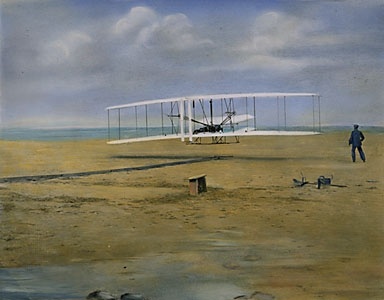 In the late 19th century North Carolina's economy began to develop a stronger manufacturing sector, led by the growth of textile mills and cigarette production. The Piedmont area became dotted with cotton mills. With the invention of a cigarette-making machine in the 1880s and the ensuing rise of cigarette consumption, tobacco manufacturing plants expanded, mainly in the Winston-Salem area. By the early 20th century the state's income from manufacturing had become more important than farm income. Moreover, North Carolina had entered the age of aviation with the first successful piloting of a powered aircraft in 1903 by Wilbur and Orville Wright (Wright, Wilbur and Orville) on the sand dunes of Kitty Hawk, near Roanoke Island.
In the late 19th century North Carolina's economy began to develop a stronger manufacturing sector, led by the growth of textile mills and cigarette production. The Piedmont area became dotted with cotton mills. With the invention of a cigarette-making machine in the 1880s and the ensuing rise of cigarette consumption, tobacco manufacturing plants expanded, mainly in the Winston-Salem area. By the early 20th century the state's income from manufacturing had become more important than farm income. Moreover, North Carolina had entered the age of aviation with the first successful piloting of a powered aircraft in 1903 by Wilbur and Orville Wright (Wright, Wilbur and Orville) on the sand dunes of Kitty Hawk, near Roanoke Island.North Carolina since 1900
 North Carolina in the 20th century was a part of the national experience of changing economic cycles. A decade of significant economic and social developments followed World War I, but the Great Depression of the 1930s brought widespread hardship and severe curtailment of education and other public services. However, the state benefited from national programs implemented under Franklin D. Roosevelt (Roosevelt, Franklin D.)'s New Deal, which intervened in North Carolina's economy during the depression years to bring relief to the unemployed and price supports to farmers.
North Carolina in the 20th century was a part of the national experience of changing economic cycles. A decade of significant economic and social developments followed World War I, but the Great Depression of the 1930s brought widespread hardship and severe curtailment of education and other public services. However, the state benefited from national programs implemented under Franklin D. Roosevelt (Roosevelt, Franklin D.)'s New Deal, which intervened in North Carolina's economy during the depression years to bring relief to the unemployed and price supports to farmers.In the 1940s the national defense program and World War II (1941–45) further rejuvenated the North Carolina economy. Some of the country's largest military installations were located in the state, notably Fort Bragg at Fayetteville. North Carolina was a major supplier of manufactured war matériel, and it delivered more textile goods to the military than any other state.
The state began a period of rapid change after the war. New highways were built, and cities grew as new industry and new people moved to the state. North Carolina experienced a sustained period of growth and has maintained one of the strongest economies in the country. Its manufacturing base remained stronger than those of most states, and its service sector grew, especially in banking and in various research-based activities. Cities like Charlotte and the Raleigh-Durham area acquired much new business activity and tens of thousands of new residents.
Interest in politics revived, and by the 1970s the state again had a viable two-party system. In 1973 a Republican governor took office for the first time since the 19th century, and another served in 1985–93. The painful struggle to eliminate racial segregation (segregation, racial), beginning in the public schools in the 1950s and at the lunch counters in Greensboro in 1960, absorbed the state's energies throughout the 1960s. While most racial segregation had ended by the 1970s, the state continued to be burdened by the remnants of earlier discriminatory practices and prejudicial attitudes. In the early 21st century North Carolina continued to face the enormous challenges of extending the benefits of education and economic prosperity to all its citizens and eliminating the last remnants of racial discrimination.
Additional Reading
Overviews of the state are provided by Federal Writers' Project, North Carolina: A Guide to the Old North State (1939; reprinted as North Carolina: The WPA Guide to the Old North State, 1988), which is still worth consulting; and James A. Crutchfield (ed.), The North Carolina Almanac and Book of Facts, 1989–1990 (1988). Richard E. Lonsdale, Atlas of North Carolina (1967), shows points of local and historical interest. James W. Clay, Douglas M. Orr, and Alfred W. Stuart (eds.), North Carolina Atlas: Portrait of a Changing Southern State (1975), gives a graphic profile of a wide variety of topics, from politics to the physical environment. DeLorme Mapping Company, North Carolina Atlas & Gazetteer, 7th ed. (2006), focuses on topography. Articles on the people, history, and folklore of North Carolina may be found in the magazine Our State (monthly).Introductions to North Carolina's history are found in William S. Powell, North Carolina (1977, reprinted 1988), and North Carolina Through Four Centuries (1989); Hugh T. Lefler and William S. Powell, Colonial North Carolina: A History (1973); H.G. Jones, North Carolina Illustrated, 1524–1984 (1983); and Lindley S. Butler and Alan D. Watson (eds.), The North Carolina Experience: An Interpretive and Documentary History (1984). Plantations and slavery are examined in Jeffrey J. Crow, The Black Experience in Revolutionary North Carolina (1977).An excellent presentation of antebellum politics is Harry L. Watson, Jacksonian Politics and Community Conflict: The Emergence of the Second American Party System in Cumberland County, North Carolina (1981). A good study of economic and political change in the late 19th century is Paul D. Escott, Many Excellent People: Power and Privilege in North Carolina, 1850–1900 (1985). Perhaps the best study of the civil rights movement in North Carolina is William H. Chafe, Civilities and Civil Rights: Greensboro, North Carolina, and the Black Struggle for Freedom (1980).
- V.P. Singh
- Vrancea
- vrata
- Vratsa
- Vreeland, Diana
- Vreni Schneider
- Vries, Adriaen de
- Vriesea
- Vries, Hugo de
- Vrije Volk, Het
- vrātya
- V Sackville-West
- Vsevolod Illarionovich Pudovkin
- Vsevolod Mikhaylovich Garshin
- Vsevolod Vyacheslavovich Ivanov
- Vsevolod Yemilyevich Meyerhold
- V.S. Pritchett
- VTOL airplane
- Vuillard, Édouard
- Vuk Stefanović Karadžić
- Vulcan
- Vulcan automatic cannon
- vulcanization
- Vulcano Island
- Vulci